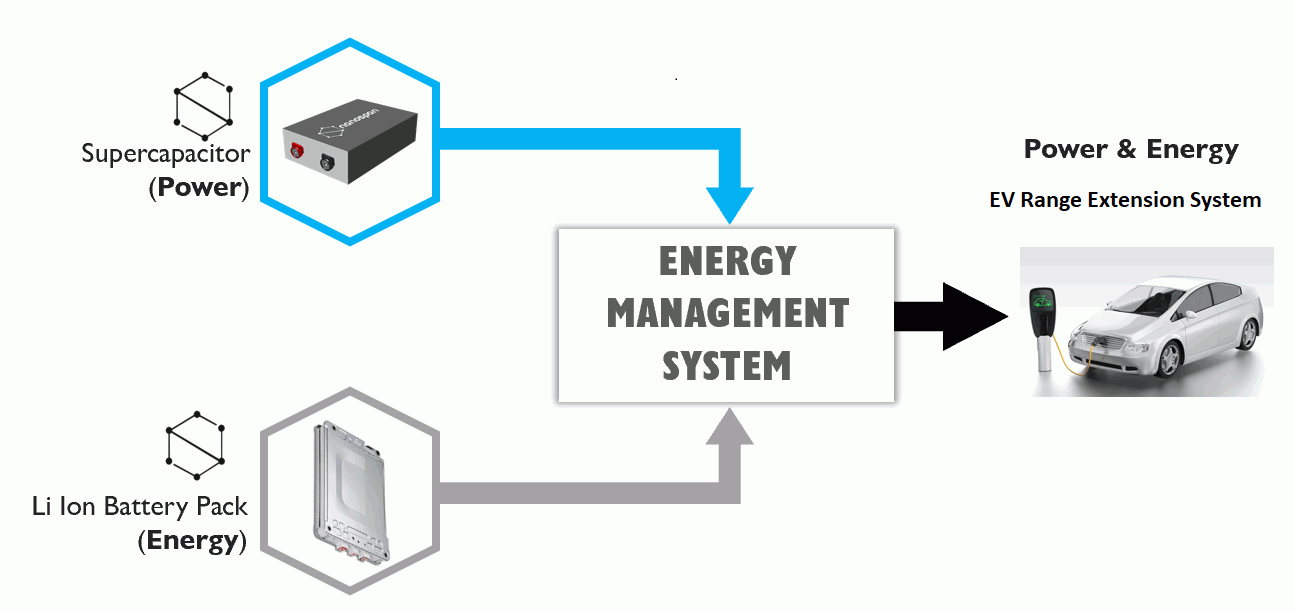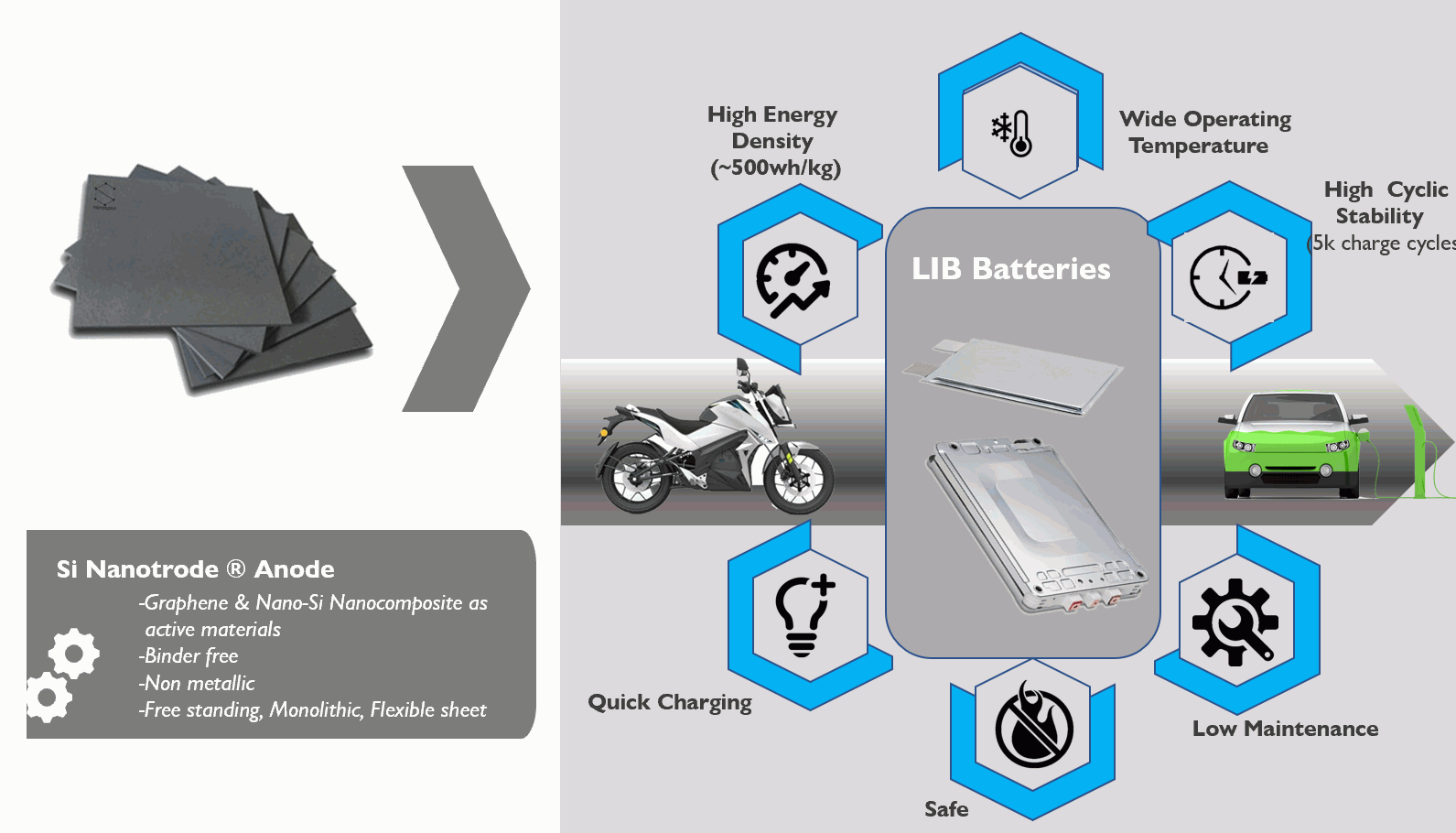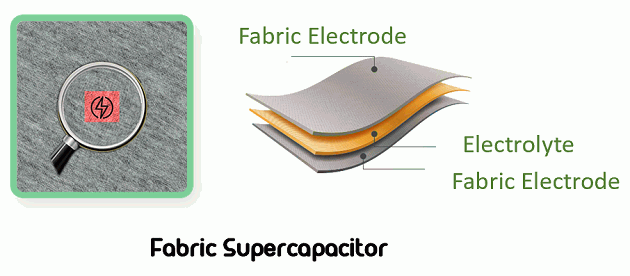Nanospan's energy storage solutions are geared towards providing high performance, safe and physically flexible energy storage solutions for EVs, flexible electronics and wearables.

Ultra High Energy Lithium Ion Battery Cells
Silicon anodes and NMC cathodes are the next generation of lithium-ion battery technology and are increasingly replacing Li Iron phosphate batteries in EVs. Nanospan with its choice of Si-Nanotrode as an anode, will be able to store ten times more energy than that of graphite. Our batteries are expected to outperform other NMC chemistries available in the market with their energy densities (~500Wh/Kg) and offer superior safety attributes. With longer battery life and smaller batteries, Nanospan offers the perfect battery cell choice for the battery packs for the EVs.
Nanospan's batteries are used in various applications in automotive, industrial, consumer electronics and grid & renewable energy domains. For the consumer goods, silicon anode batteries are also utilized in digital cameras, mp4 players, cell phones, laptops, tablets, and several other microelectronic devices.

Supercapacitors
Nanospan's supercapacitors are primed for EVs because of their high power density and their safety & physical attributes. They are also ideal for Wearable & flexible electronic devices because of their physical flexibility and energy density. Supercapacitors are being increasingly used in consumer electronics, computers, smartphones for memory protection, as a short-term redundant backup supply or to facilitate instant charging.
Some known industry use cases of supercapcitors are:
Automobiles
The supercapacitor-battery combination is used to improve the fuel efficiency of the automobile by offloading high power use case needs to supercapacitor.
Supercapacitors are used currently to provide peak current during starting and acceleration of the train, stabilizing the catenary voltage resulting in up to 30% energy savings depending on the driving modes.
Electronic devices
Supercapacitors are being increasingly used in consumer electronics, computers, smartphones etc. They are designed into these products for memory protection, short-term redundant backup supply or to facilitate instant charging.
Energy storage for smart fabrics
Nanospan's supercapacitor can blend with the fabric and be flexible, durable and capable of functioning in extreme weather conditions.
One example application is the soldier assisting thermal managing vest, which can help monitor the health of the soldiers', patrolling the country's borders in extreme cold places and glaciers. The current choice of power source for such a vest is to attach a cumbersome battery pack, which fails in extreme weather and is also a big hurdle for making effective vests. Nanospan's energy storage device can not only blend into the fabric but will also be lightweight, quick charging, safe, bio-compatible, washable, rugged (work in -40 degrees to room temperature) and have high cyclic stability. i.e. be able to withstand more than 20k charging cycles.

Space, Aerospace, Railways
Supercapacitors are used to power emergency actuators during emergency in airlines, because they provide a reliable and short burst of energy required in such applications.

The Safe, solid state, flexible form-factors, durability combined with lightweight, quick charging, safe, rugged (work in -40 degrees C to room temperature) and the very high cyclic stability properties of Nanospan's supercapacitor is ideally suited for powering the high power density requirements of the electronic and electrical systems in Space and Aerospace industry.
SAFE+ Battery Enclosures
Most battery technologies today are vulnerable to explosions, melting, catching fire and acid leaks when exposed to stressful or severe environmental conditions. Proper battery enclosures can protect the hosting applications and users from such hazards.
Nanospan's material technologies offer highly desirable alternatives when compared to current choices of :
Some industry use cases were SAFE+ Battery Enclosures provide an ideal solution:
- the battery cells for EVs and home energy storage that are incased in liquid, which makes it cumbersome and prone to high maintenance.
- thermoplastics which can be temperature sensitive polymers and have poor thermo mechanical properties.
- metallic enclosures mainly steel and metallic alloys. Metallic enclosures are good in mechanical properties but they are susceptible to deformations due to temperature issues which are prevalent in high power battery packs. Moreover metallic enclosures are high weight which can impact the final Wh/kg ratings
Defense
Batteries typically account for nearly a quarter of the weight carried by soldiers in the field. Incidentally these batteries have also become a potential hazard to the soldier carrying them when they are faced with ballistic threats. There are many documented cases of overheating, leakage of electrolytes, overheating and catching fire, causing injury to the person carrying them.
Mobile and mobile computing devices: Documented cases of string of lithium-ion battery fire issues over the past decade.
Aerospace
Battery systems inside an Air plane are expected to perform with zero fire risk. Battery fire was identified as the root cause for some air crashes in recent history.
In the commercial aviation industry worldwide, the lithium battery power banks are banned from being carried in the passenger check-in baggage because of the potential fire hazard.
Nanospan's energy and battery enclosure solutions are ideally suited to contain such hazards.